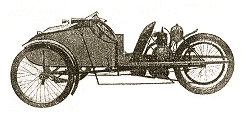 |
Atomette |
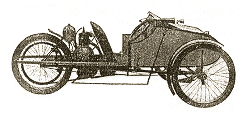 |
| In 1921 Mr. Allan Thomas, who had a garage at 25 Cleveland Street,
Wolverhampton, designed and built several prototype three-wheeled,
single seater cars, using the name Atomette. The
following year he introduced a two seater cyclecar. The machine, powered by a 2.5hp. two-stroke,
air-cooled Villiers engine, mounted behind the seat, was fitted with a three speed Burman
gearbox. The engine was fitted immediately in front of the
rear wheel and even though it was behind the seat, cooling was
adequate. There was a primary chain drive and a single rubber belt
for the final drive, which ran onto a 'V' shaped pulley on the rear
wheel. The pulley also accommodated two shoe type brakes. |
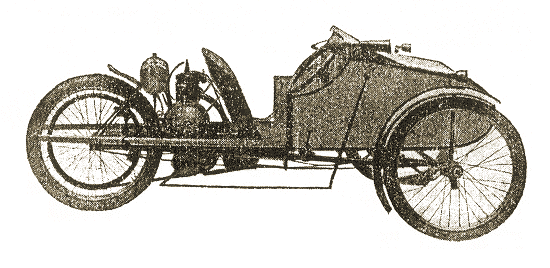
A single-seater 'Atomette' cyclecar from
1921. From the 'Light Car & Cyclecar' magazine.
| The frame was built from two cross-braced tubes which were strengthened
by tie rods. The back wheel was unsprung to reduce the possibility of
skidding, and quarter-elliptic springs were attached to the front axle.
There was direct steering with a moveable steering column to facilitate
the driver's entrance. The other controls were similar to those found on
motorcycles of the day, and the body was made from three-ply wood. Only
a few were built, and production lasted for about a
year. The following article appeared in the "Light Car and
Cyclecar" on 4th
March, 1922: |
| The Atomette cyclecar, made by Mr. Allan
Thomas, of Cleveland Street, Wolverhampton, has undergone several
changes since it was first described in these pages, and it was on
the new two-seater that we recently had the pleasure of a trial run.
The specification is generally the same as that of
the single-seater, with an air-cooled
2hp. Villiers engine, three-speed Burman gearbox, and chain-cum-belt
transmission to the rear wheel. The rear wheel is rigid, but the
body itself is mounted on transverse leaf springs, quarter-elliptic
springs being supplied in front. The engine is situated behind the
seat, and is cooled by an aluminium fan.
Handle starting has been replaced by a kick
starter on the Burman gearbox. Owing to the cold weather, both
driver and passenger were heavily clothed, and the seating
accommodation was, therefore somewhat cramped. We understand,
however, that the body is an experimental one and that those
supplied to the public will be two or three inches wider and longer.
This, in conjunction with the movable steering column, should
provide ample room for average-sized persons. |
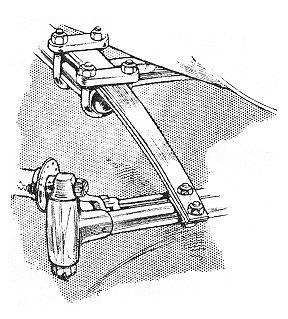
Exemplifying the simplicity of the whole
design. The front quarter-elliptic springs are anchored direct to
the tubular chassis member. The sketch also shows the simple-type
steering pivot. |
|
Capable of 30 m.p.h.
The Atomette is not claimed to be a
"go-anywhere" cyclecar. It is a simple and economical runabout,
which, at 90 guineas, will take two persons in warmth and comfort
over any ordinary roads. We were surprised, however, to find that a
speed of 25-30m.p.h. could be reached. The springing was not by any
means perfect, but it was reasonably good, and the rough roads of
Wolverhampton were traversed with very little discomfort. Tettenhall
Rock Hill, an ascent which necessitates a change down on many cars,
was climbed by the Atomette, two up, in top gear, and Old Hill, in
the same district, which has a gradient of about 1 in 6, was
negotiated in bottom gear without difficulty.
|
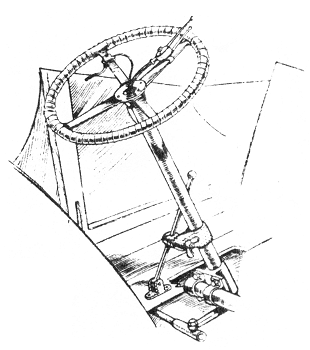
The ingenious method of altering
the rake of the steering wheel. It is fixed in the
desired position by means of the wing nut. |
The Atomette weighs, approximately, 2½cwt.
which is about the weight of a medium-powered solo motorcycle. A
reverse gear is therefore, altogether unnecessary, for the machine
can easily he pushed with a hand on the steering wheel. Another
advantage of its lightness is that it can be tipped up either way,
thus making it simple for the transmission, etc. to be attended to
should this become advisable. When it is wished to get at the
carburettor or sparking plug, the expanded metal door above the
engine can be raised. Should this not give sufficient room for the
job, the back portion of the body, which contains the petrol tank,
can be removed complete by undoing the petrol pipe union and taking
off four winged nuts.
A Sturdy Two-stroke Engine.
After a run of several miles, we found the
engine quite cool and developing its full power. Also, as it was
always running under load, there was a total absence of
four-stroking. There is a pleasure in driving this sturdy, but
featherweight, cyclecar, which has to be experienced to be
appreciated. |
|
Even
at full speeds, it is remarkably steady on the road due, no doubt,
to the rigidity of the back wheel, and its narrow track and good
accelerating power proved great assets in traffic. It can he stored
in any shed which has a door of sufficient width, and can easily be
lifted up a step should this shed be on higher ground than the road.
Over ordinary roads an average speed of about 17 or 18m.p.h. can be
maintained without difficulty.
An ingenious feature is the manner in which the
rake of the steering column can be altered. This column, as can be
seen, is anchored at its base to a cross tube, the angle of the
column being governed by a diminutive radius rod secured to the
floor of the car. By slacking off a single wing nut the steering
wheel can be pushed away from or pulled towards the driver until the
most comfortable angle is found, and the steering column can then be
locked. |
 |
Return to
the list
of manufacturers |
|